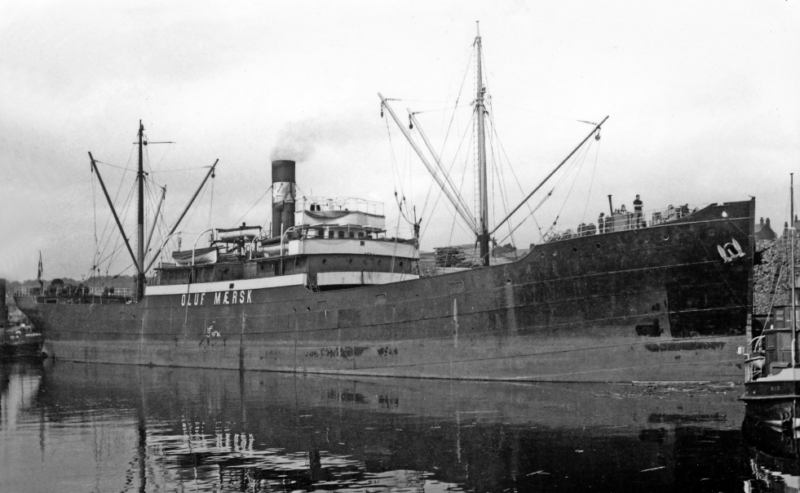
The biggest container ship company in the world had very humble beginnings 116 years ago on 16th April 1904, its affairs being run from the Møller home of Villa Anna in the fishing and boat building town of Svendborg on the south coast of the island of Fyn between the Great Belt and Little Belt of Denmark. On that April day, Capt. Peter Mærsk Møller (1836-1927) and his son Arnold Peter Møller (1876-1965) and four other prominent citizens of Svendborg became directors of the D/S Svendborg A/S (Svendborg Steamship Company) with a capital of 150,000 Danish kroner in Dkr 500 shares. Arnold Peter Møller was employed at the time in the busy Copenhagen office of established ship owner C. K. Hansen as a Chartering Manager, but together with his father took 46% of the issued shares. The very small steamer Laura had been under the command of Capt. Peter Mærsk Møller in 1886, and also later by another son, Hans Mærsk-Møller, the hyphenated surname clearly showing both the Mærsk and the Møller sides of the family.

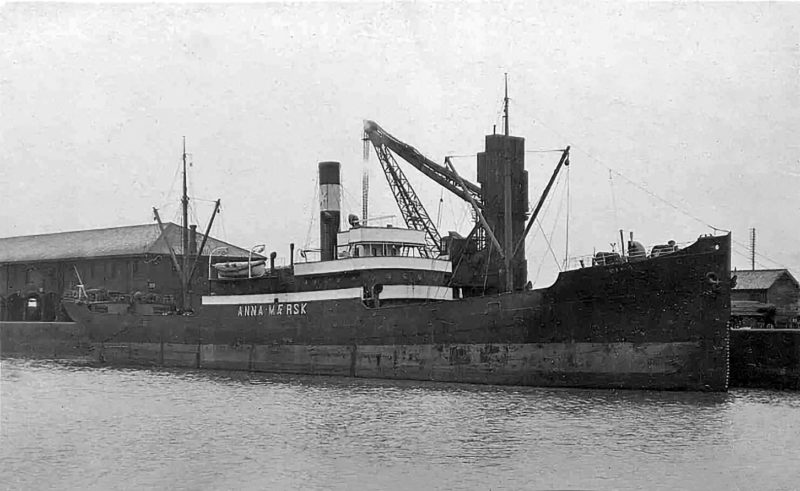
FIRST SHIP OF A GREAT FLEET
The first steamer was purchased six months later on 6th October in the Sunderland built Ada of 1901 from Cardiff owners and was renamed Svendborg after her home port. She was given a black funnel with a central seven pointed white star, which was later worn on a central pale blue band. Svendborg was a busy fishing and boat building town, with also other industries, but only two out of the twenty yards have survived until recently. The new steamer had recorded a reasonable profit during her first year of trading by October 1905. The second steamer was delivered new from a Dutch yard in September 1906 as Peter Mærsk with her sister Anna Mærsk delivered two years later from the same yard as the third ship of the new fleet.
Arnold P. Møller married Chastine Estelle McKinney on 30th April 1910 at her home town of Mayview near Kansas City. They set up home near to Copenhagen and raised four children with the second born in Arnold P. Møller (2) in 1912, who became the future leader of the company for many years, and the foundation of very close links with the United States of America.
Anna Mærsk ran aground leaving Ventspils in January 1911 and was held fast throughout the winter until salvaged by Svitzer of Copenhagen in May and repaired. Arnold P. Møller was working very long hours in the C. K. Hansen ship owner office in Copenhagen while overseeing the affairs of the Svendborg company and its shareholders. He needed another company directly under his own control, which was founded in Copenhagen on 22nd August 1912 asD/S af 1912 A/S (Steamship Company of 1912).The first pair of ships were purchased from Hansen and renamed Lexa Mærsk and Hulda Mærsk. Arnold P.Møller then left C. K. Hansen employment on 1st January 1913 to concentrate fully on ship management for the two new Møller companies, which began with an office staff of four in Copenhagen.
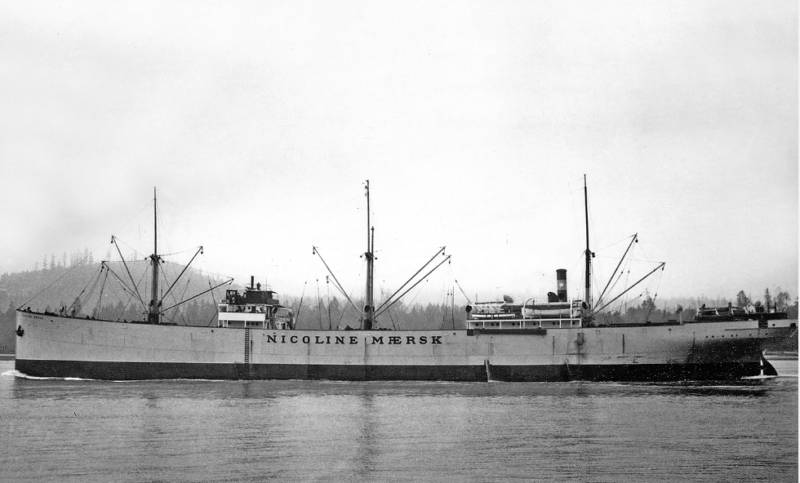
The outbreak of war in August 1914 saw the Møller fleet of ten Baltic and North Sea traders continuing in their trades of timber and pit props to Britain and the Continent, returning with coal. Attempts were made to trade into the U.S.A. away from the war zone, however two ships were lost to German action during the war. During his business trips to West Hartlepool, Arnold P. Møller had become very impressed with the shipbuilding and ship owning business of Sir Robert Ropner of that town. He was determined to use the great benefits of building ships at cost price in the Møller fleet at some point in the future. Land was acquired at Odense in 1917 and three slipways for ships up to 390 feet in length were operational in 1920.
At the first meeting of the British & International Maritime Council in June 1920 after the war, Arnold P. Møller moved a resolution calling for greater freedom of the seas to be maintained. BIMCO had been set up in February 1905 by Newcastle upon Tyne and Scandinavian ship owners to encourage free trade.
The first diesel engine powered ship was delivered from the Odense yard for the worldwide tramp trades as Leise Mærsk in September 1921. These included the Mediterranean homeward trades of bauxite, phosphates and iron ore with a large contract for phosphate from Morocco to Denmark, the traditional grain trade from the Plate, timber and paper pulp from Newfoundland to the U.K., and the Australian and Far East tramp trades.
A further four diesel engine ships entered the tramp trades for Møller during the mid and late 1920s as Sally Mærsk, Chastine Mærsk, Emma Mærsk and Nicoline Mærsk. The steamer Chassie Mærsk built in 1920 was wrecked on 7th January 1922 in very bad weather and poor visibility on an island near Sabang at the northern tip of Sumatra. She had sailed from Hamburg with salt and cellulose for Calcutta and bunkered on the Tyne before passing into the Suez Canal on 16th October 1921 and arrived at Calcutta on 6th November. She then ballasted down to Durban for coal and sailed on 17th December on her last voyage to Sabang.
Arnold P. Møller established his first regular liner service as Mærsk Line on 12th July 1928 linking the U.S.A. with Japan and Asia. Leise Mærsk made the first sailing when she sailed that day from Baltimorevia Panama for the Far East. The first five tankers in the fleet and on charter to Shell and Esso were added by the end of 1928, which had reached 35 ships by the then
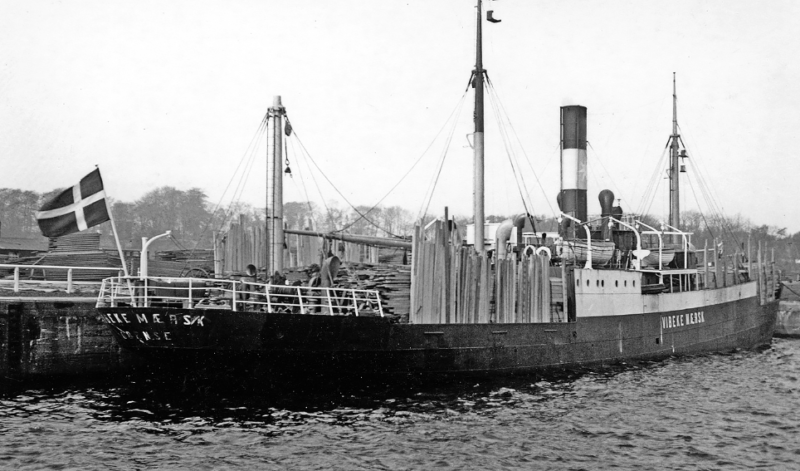

Gertrude Mærsk was delivered from the Odense yard in May 1930 as the first of five new Mærsk Linediesel cargo-liners for the new Pacific service. She was followed over the next four years by Niel Mærsk, Peter Mærsk, Anna Mærsk and Nora Mærsk, the latter also having a fuel efficient Maierform hull. The winter of 1931 was severe with the Baltic iced up and eight Møller Baltic traders laid up at Copenhagen and Svendborg for want of employment. A diversification had been made into whaling, with the part owned whale factory ship Sir James Clark Ross purchased and renamed Fraternitas together with five whale catchers renamed Tas 1 to Tas 5 from Star Whaling A/S. The whaling fleet was sent to the Antarctic during the 1936/37 southern season but failed to make a profit and was sold off.
The cargo-liner Nora Mærsk was burnt out on 26th July 1936 at Zamboanga in the Philippines with a cargo of copra, and had been in service for only two years. The ventilated reefers Robert Mærsk an Gudrun Mærsk entered service suitable for the carriage of apples, however a third fully refrigerated shipF rancine was withdrawn after trading difficulties and was sold to J. Lauritzen of Copenhagen. Two German built and one Odense built cargo-liner with fuel efficient Maierform hulls entered service in 1938/39 asGrete Mærsk, Marchen Mærsk and Laura Mærsk. Two slightly smaller sisters from the Odense yard were completed as Hulda Mærsk and Lexa Mærsk.
On the outbreak of war on 3rd September 1939, the A. P. Møller fleet consisted of 47 ships including nine tankers which were on charter to Shell and Esso, some for U.K. coastal trading. German forces drove into Denmark on 8th April 1940 and occupied Copenhagen. Arnold P. Møller directed the fleet to sail to the nearest neutral port.
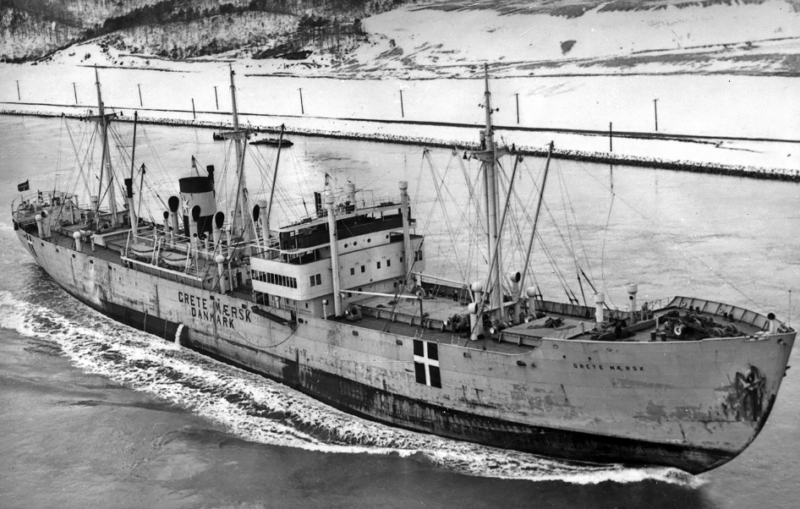
However, most of the smaller fleet of Baltic traders fell under German control, while the majority of the deep sea fleet escaped to sail under the British, American, Spanish, South African and Irish flags. Mærsk McKinney Møller, his son, escaped to the U.S.A. with his new bride Emma Rasmussen. Their stay was a very long one, not returning until seven and one half years to Copenhagen, which had suffered relatively little damage compared to the total destruction of German ports such as Hamburg, Kiel, Bremerhaven, Wilhelmshaven, Flensburg, Lubeck, Brunsbuttel, Cuxhaven and others. In contrast to the few losses in the Great War, the Møller fleet was to be decimated with two dozen ships lost to enemy action and several more becoming marine losses, leaving only seven war weary survivors afloat at its conclusion. A total of 148 brave Danish seafarers lost their lives on company ships during the war.
POST WORLD WAR II TRADING
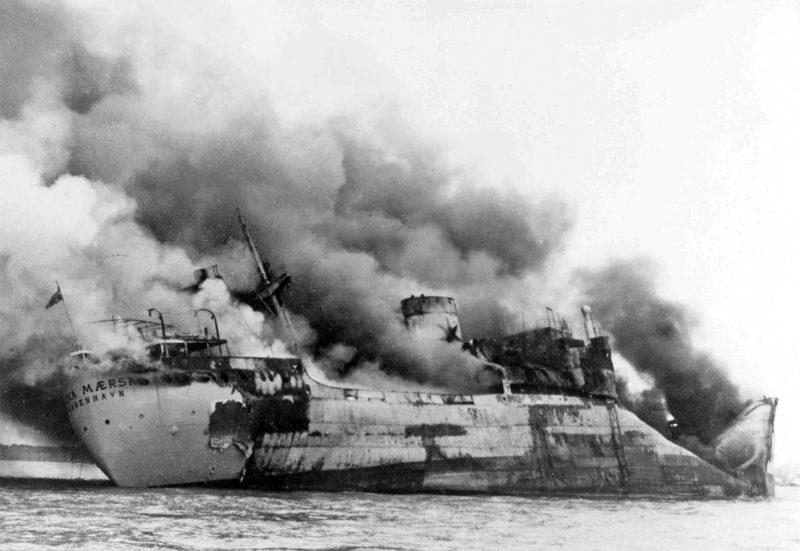
Fleet rebuilding got underway in 1946 with the purchase of two ‘Liberties’, four C1A types, and four ‘Hansa’ design vessels. A further twenty cargo-liners of 9,750 dwt, and 13 of between 5,000 and 6,000 dwt were delivered from British, Danish, Italian and Japanese yards over the next ten years. Mærsk Line begain 1947 a Transatlantic service with war relief American shipments to Le Havre, Antwerp, Rotterdam and Hamburg under the Marshall Aid Plan, which ran for seven years until relief deliveries were terminated. Mærsk Orange Line ran with citrus fruit from Palestine to Northern Europe but ceased at the same time as the Transatlantic Line due to unprofitability. The tanker fleet replacement programme got under way in 1948 with the delivery of the first of thirty tankers of between 16,000 and 19,000 dwt, with the delivery of another six of 12,950 dwt, from British, Swedish, Danish and Japanese yards.

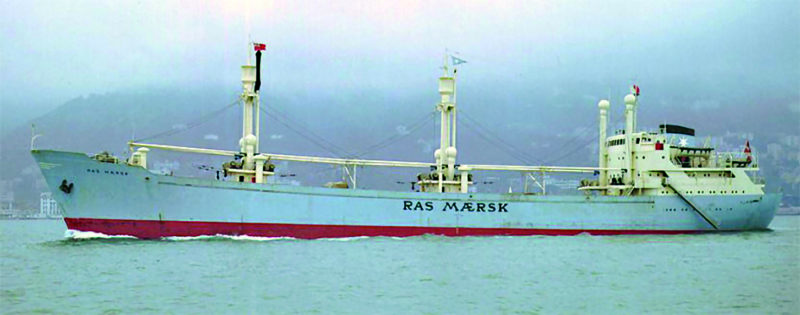
Mærsk Line had to remain firmly outside the Far East Freight Conference (FEFC), having been denied admission by the powerful British, French and Scandinavian founding liner companies. After much struggle, Mærsk Line was finally allowed very limited loading rights at the Italian port of Genoa as its only European port of call in 1957 and admitted to the FEFC. The size of the Møller cargo-liner fleet enabled the start of a fairly regular expansion of the well established Mærsk Line Pacific service to include the South East Asian ports of Singapore, Bangkok, Colombo and South India as well as Aden and Red Sea ports up to the Suez Canal and on to Genoa. This allowed a precious change of crews at Genoa by air direct from Copenhagen before their ship sailed direct for the Eastern Seaboard of the U.S.A. Thus, the foundation of the present day Round the World service had been laid, however with the closure of the Suez Canal in 1956/57 and again between 1967/75 access to Genoa was via the Straits of Gibraltar.
The fleet had recovered to twice the size of the 1939 tonnage by 1953, standing at 600,000 dwt, however Lexa Mærsk caught fire on Christmas Day 1954 in Singapore Roads while loading rubber and was reduced to a smoking hulk by Boxing Day, fit only for breaking up. The Mærsk blue hull colour was introduced in 1955 at the launch of the supertanker Regina Mærsk by Queen Ingrid of Denmark. This was a darker shade of blue, and by the end of 1957 all of the fleet had been repainted in a paler shade of blue known as ‘Mærsk blue’. The Mærsk Line fleet much later became known as ‘Big Blue’ of the shipping world when it had achieved a dominant position. Hulls had been mostly black until 1928, then light grey.
The five hold Ras Mærsk of 5,400 dwt became the first ‘all aft’ design in the fleet in 1957, henceforward all of the fleet had the bridge structure placed aft. A new cargo service was begun in 1958 from U.S. Gulf ports to West Africa in conjunction with Nopal Line of Oivind Lorentzen of Oslo, but only lasted three years before becoming unprofitable. A new shipyard was completed in 1959 further down Odense fjord at Lindo near Munkebo in order to construct much larger vessels, the existing yard at Odense continued in production for another seven years as a sub-contractor to the new yard. Some 86 ships had been built for Group account during the period between 1920 and 1965. The last ship built at Odense was the bulker Laura Mæersk, and for other owners the Brazilian tanker Taquipe, part of a six ship order for Petroleos Brasileiro S. A. with Danish shipbuilders.
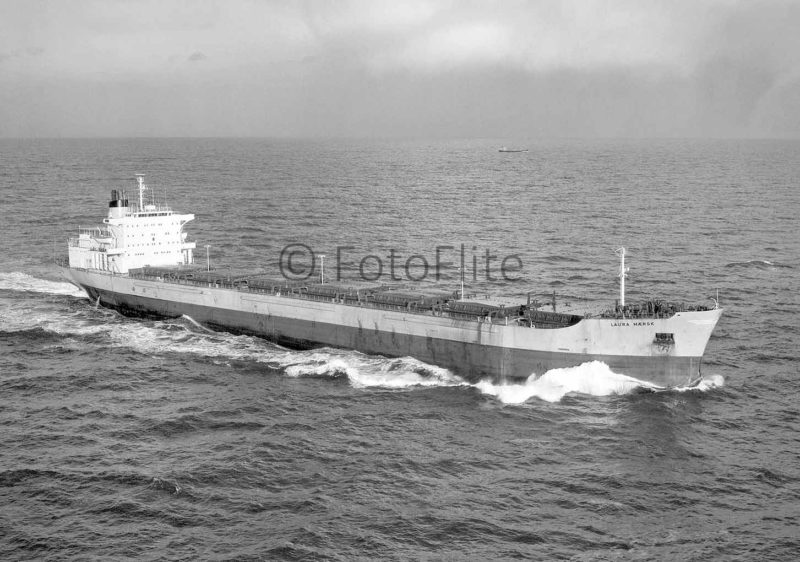
The first turbine tanker Caroline Mærsk entered service in 1960 with a further thirty turbine tankers entering service with the Group up to 1977. Georg Andersen was made the third partner in A. P.Møller in 1959, having joined as an apprentice in 1922 and he became Manager of Mærsk Line in 1945.Arnold P. Møller had three brothers and six sisters, Georg Andersen being one of his nephews. Laust Mærsk collided with the American ship Alcoa Pioneer on 5th February 1961 in Yokohama Bay and sank. Anew ‘T’ class of cargo-liners entered service in 1961 on the Round the World service via Panama and quickly gained approval from shippers with their high service speed and fast turn round. The fully refrigerated Dragor Mærsk from the Odense yard marked a re-entry into the reefer market on charter to Salen of Sweden.
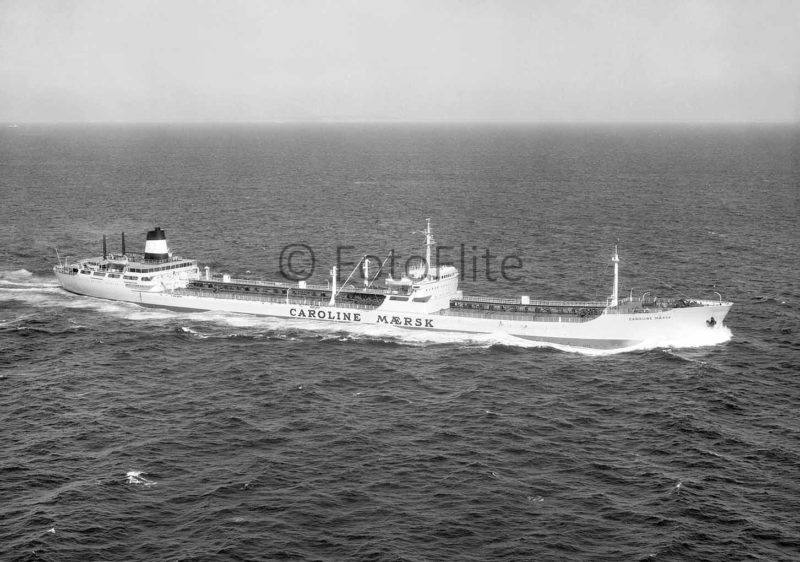
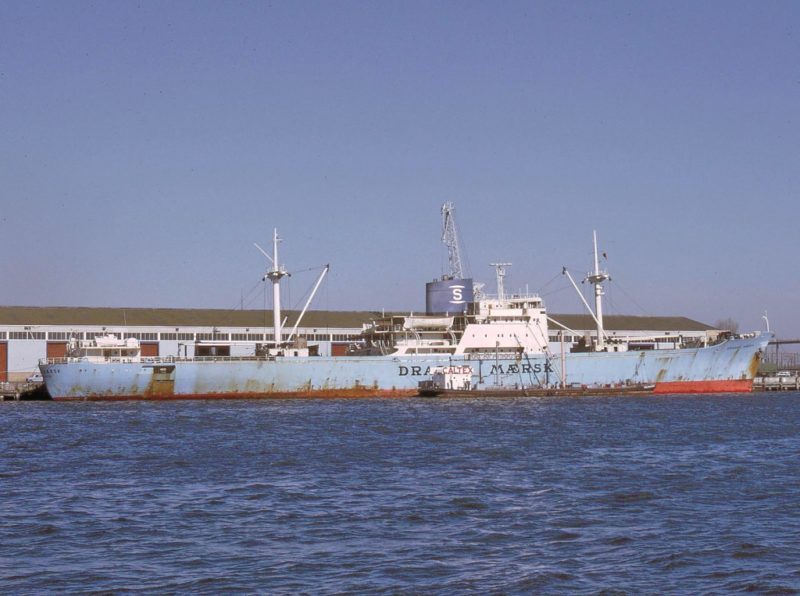
A period of diversification began in 1961/62 away from shipping with the purchase of RoulundsFabriker, a disc brakes and car parts manufacturer, as well as their subsidiary of Ro-Clean Desmi A/S to manufacture open sea containment booms, skimmers and other oil spill response equipment. An exclusive concession right for the exploration and production of the Danish oil and gas reserves in the North Sea was obtained, and the DUC (Dansk Undergrunds Consortium) was formed with Texaco and Shell. The DanskSupermarked A/S subsidiary was formed in 1964 in collaboration with F. Salling A/S, which later became Denmark’s second largest supermarket operator, with NETTO discount stores and BLKA hypermarkets and other retail names becoming established in Britain, Germany, Poland and Sweden. The discount supermarket sector was later taken over by the German ALDI and LIDL brands. Mærsk Air was formed in 1970, principally for the Odense to Copenhagen route frequently used by commuting Møller executives and was later extended to Danish domestic and international routes. Rosti Plastics A/S was acquired in 1971 with products such as bottles, thermoplastic packing foam, brightly coloured kitchen ware and plant pots, all now replaced by eco-friendly alternatives.
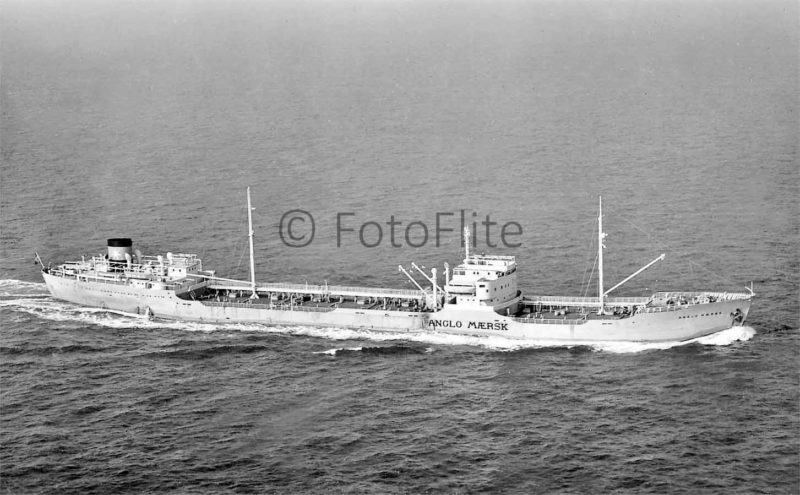
The tanker Anglo Mærsk exploded on 23rd April 1962 after a fire in her engine room off Dominica, she drifted powerless until she sank off Antigua while on a voyage from Trinidad to Rotterdam with oil. The first two Møller bulk carriers, Janecke Mærsk and Jesper Mærsk, entered service in 1962 in a joint 50/50 partnership with bulk trades specialist Erling Naess. Nine tankers were converted into bulk carriers in Japan in the early 1960s, by replacing their tank midbodies by new bulk carrier sections and repositioning their bridges on top of their aft superstructures. Two of these were sold in 1964 to Safmarine of South Africa in a joint venture Safbulk (Pty) Ltd. for the pig iron trade from Durban to Yawata and were renamed with ‘Safdan’ names. Two further converted vessels retained their Mærsk names while operating in the same trade until A. P. Møller terminated the joint venture in January 1966.
The Japanese built sisters Sofie Mærsk and Sine Mærsk of 77,450 dwt were the first purpose built ‘all aft’design of tankers in 1964 for Mærsk. Two further fully refrigerated reefers entered service as Thuro Mærsk and Magleby Mærsk on charter to Salen of Sweden. The principal Mærsk Line services at this time were:-

ROUND THE WORLD SERVICE
U.S. Eastern Seaboard Ports via Panama to U.S. and Canadian West Coast ports, Japan, Hong Kong, Philippines, Singapore, Bangkok, Colombo, Indian ports, Aden, Suez Canal, Genoa, U.S. Eastern Seaboard on a five month voyage rotation.
- JAPAN TO INDONESIA This route began in 1952 after Indonesian independence with British and Dutch competition quickly withdrawn, leaving only Japanese lines, Indonesian State shipping and Mærsk Line on the route.
- JAPAN TO THAILAND Railway rolling stock from Japan to Bangkok returning with rice, tapioca etc. A Branch office was opened in Bangkok in 1952.
- JAPAN TO PERSIAN GULF Japanese ports, Hong Kong, Bangkok, Colombo, Indian ports, Karachi and Dubai.
- JAPAN TO WEST AFRICA This route began in 1959 via Hong Kong, Singapore, and South Africa and has since become a cornerstone in present day Mærsk Line world services, particularly with the advent of larger feeder container ships.
- CEYLON (SRI LANKA) TOPERSIAN GULF ROUTE Tea was the principal commodity westwards in two special small ships completed in 1961 as Niels Mærskand Nelly Mærsk.
Arnold P. Møller died on 12th June 1965 aged 88 years, and his son Mærsk McKinney Møller assumed the leadership of the Group. The Mærsk Line fleet totalled 88 ships of 1.692 million dwt, with two new small product tankers of 5,210 dwt, Dangulf Mærsk and Svengulf Mærsk, in a 50/50 partnership with Gulf Oil of the U.S.A. Mærsk Line began a new Europe to the Far East service in 1968 using seven new ‘C’ class part container ships from Hamburg, Bremerhaven, Rotterdam, Antwerp to Singapore, Hong Kong, Keelung, Pusan, Kobe and Tokyo via Cape Town.

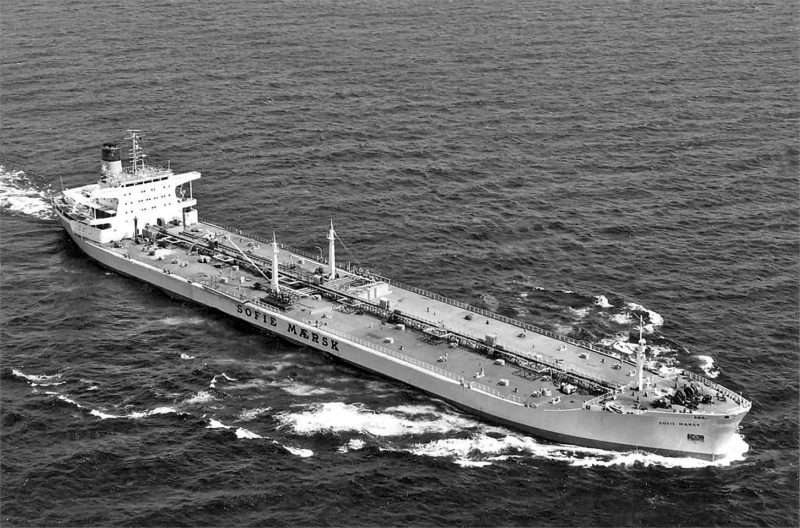
The Lindo yard was extended in 1969 with a new shipbuilding dry dock capable of building ships upto 650,000 dwt. The building dock has dimensions of 415 by 90 by 11 metres with an outfitting quay of equal length. Two smaller building docks capable of building ships up to 200,000 dwt completed this modern yard, which also built oil rig modules for the North Sea.
The A. P. Møller Group and the DUC consortium began oil production from the Dan field in the Danish sector of the North Sea in July 1972, however the first Danish gas from the Tyra field did not begin to flow until 1984. The gas came ashore by pipeline to the DONG gas treatment plant at Nybro to the north of Varde near Esbjerg.
Mærsk Co. Ltd. of London had been set up in 1951 as a shipbroking operation, but had three new ‘C’ class ships registered under it in 1972 in the bulkers Mærsk Cadet, Mærsk Captain and Mærsk Commander. The British agency expanded in 1982 with the introduction of a feeder service from Hull and Tilbury to the European terminals of the Far East service
THE ADVENT OF MæRSK – CONTAINER SHIPS
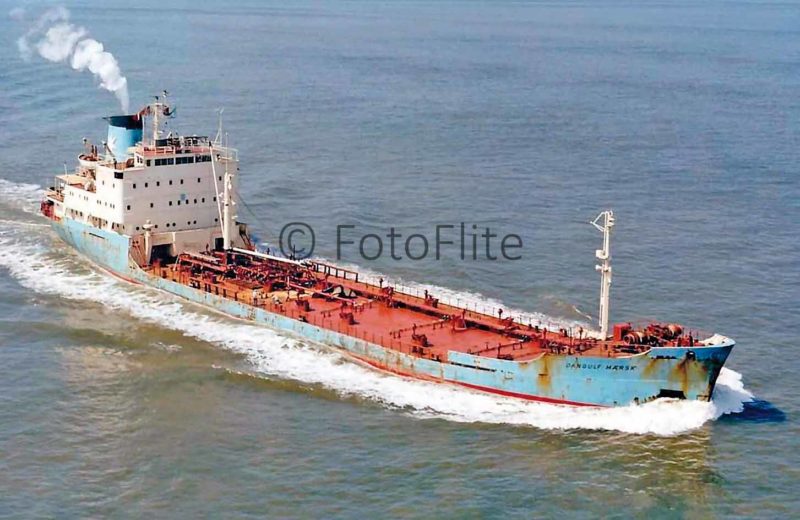

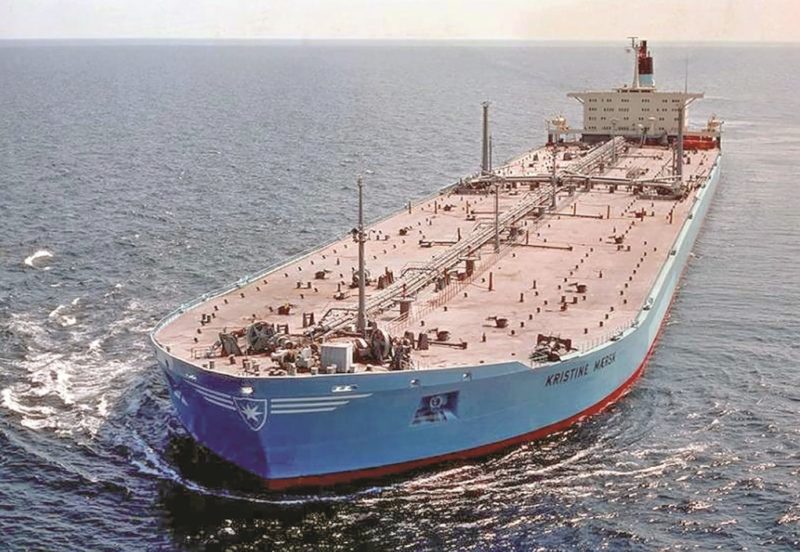
The first Mærsk Line container ship was launched as Svendborg Mærsk in November 1972 and was used at first on charter to OCL for Europe to Australasian services, and she was named after the first ship owned by the Mærsk-Møller family. The new Mærsk Line container service from East and West Coast ports of theU.S.A. to Japan was inaugurated in September 1975 by Adrian Mærsk, first of nine new ‘A’ class. Four new ‘M’ class part container ships were also introduced into the Far East to Persian Gulf service in 1975. The efficiency of the Mærsk container services was due in part to its new communications and computer subsidiary Mærsk IT.
The largest to date VLCC tanker Kristine Mærsk of 333,000 dwt was delivered in 1974 from the Lindo yard, and fifteen ‘R’ and ‘K’ class VLCCs were completed during the years between 1971 and 1977. A consortium was set up to own the LNG vessel LNG Challenger by Møller, P. & O., and Fearnley & Eger of Oslo. The latter company withdrew in 1978 and Møller in 1985. Twenty years later, Mærsk re-entered the LNG market with the new larger LNG ship Mærsk Ras Laffan.
Mærsk Company (Pte) Ltd. of Singapore was set up in 1978 to handle local port agency operations and also operate small feeder container ships e.g. Mærsk Mango and Mærsk Tempo from the Philippines, Indonesia, Malaysia and Bangkok into the main terminal hubs of Singapore, Hong Kong and Japan. The Mærsk car carriers Mærsk Wave and Mærsk Wind and the bulk carriers of the 1980s and 1990s were also registered under this Singapore subsidiary. The bulk carriers were given local names e.g. Mærsk Serangoon was named after the R.A.F. base in Singapore. The subsidiary was renamed A. P. Møller Singapore (Pte) Ltd. in 1989. Cars had previously been carried to North America on special hoistable decks on some of the Group bulk carriers. However, Møller Mærsk exited the dry bulk sector twenty years later in 2009 with the sale of its last bulk carrier.
Six ‘E’ class ro-ro vessels, also known as Caroliners, entered service in 1979 on the Far East to Persian Gulf service, having been built at Odense. They were fitted with a through deck for wheeled traffic along the length of the ship, a large quarter stern door and ramp, and could also carry 830 TEU of containers on deck and in the holds. In 1982, all except Elisabeth Mærsk were sold for conversion by Bethlehem Steel Corporation into TAKX ro-ro ships for long term charter to the U.S. Navy, but continued to be operated by Møller Mærsk. Three ‘A’ class were then re-engined and converted for ro-ro cargo to replace them on the important Japan to Persian Gulf route.
The Europe to Far East service was fully containerised in December 1980 with the advent of the new ‘L’ class Laura Mærsk, the first of her class. She operated on a fixed time rota and schedule of ports and cargo was brought to the four European terminals of Hamburg, Bremerhaven, Rotterdam and Antwerp by feeder vessels, railways, Rhine barges and by lorry. She operated in the ACE consortium formed in 1975 alongside five Far East shipping companies including Kawasaki ‘K’ Line and OOCL, and in competition with the Trio and Scandutch consortia. The ‘C’ class of 1968 were replaced and sent to Innoshima to be converted into full container ships by Hitachi by jumboizing their hulls and fitting a new forepart. In addition, the final pair of Cornelia Mærsk and Cecilie Mærsk were fitted with a large gantry crane. The ‘C’ class were transferred to the Pacific North West Coast to Japan and U.S.A. to Middle East services. The Pacific service became weekly in May 1985 to Vancouver, Tacoma and Seattle with a weekly dedicated container train connecting through to Chicago and New York.
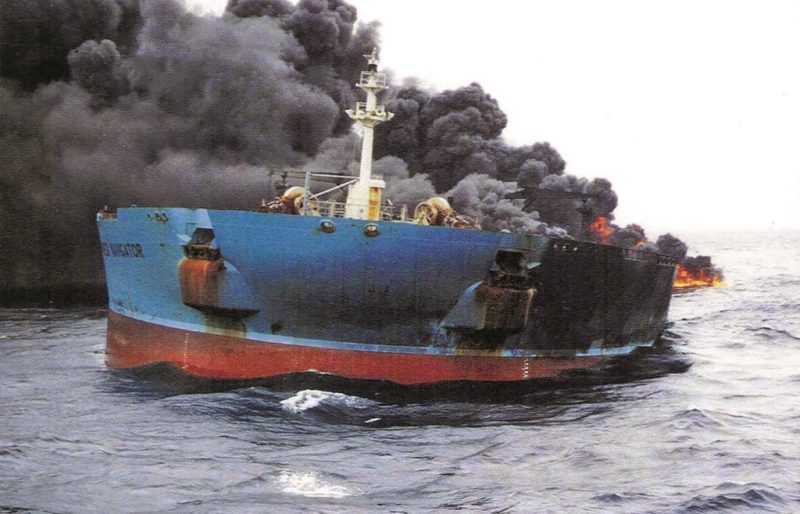
The Mærsk Møller Group was publicly listed for the first time on the Copenhagen Stock Exchange in1982. D/S af 1912 A/S and D/S Svendborg A/Swent public, but A. P. Møller itself remained firmly as a family owned partnership in control of a diversified business empire. The ‘A’ class container ship Arthur Mærsk was re-engined with a 10 cylinder Hitachi diesel engine of 45,800 bhp at Innoshima by cutting the vessel in two and fitting a new mid and stern section. A well organised schedule allowed the remaining units of the ‘A’ class to be re-engined using recycled mid and stern sections of their sisters. In addition, Adrian Mærsk, Albert Mærsk and Arnold Mærsk were fitted with a four deck garage over their stern sections to take ro-ro traffic on the Far East to Persian Gulf service. The angled stern ramp was particularly useful for ports without infrastructure, and the whole project was entitled Operation Optima to make the best use of resources.
The product tanker A. P. Møller was launched on 2nd October 1984 and named in memory of her father by his eldest daughter Mrs. Sally Mærsk at the Lindo yard. Also present at the ceremony were Mærsk McKinney Møller and other friends and relatives of the Møller family. The huge new Algeciras container terminal was begun in 1982 and was finished four years later as a dedicated Mærsk Line transhipment and loading port. Lica Mærsk called there as the first Mærsk ship to dock there on 1stDecember 1984 to inaugurate new U.S.A. to West Africa, Spain and Middle East services using Algeciras asa transhipment port for feeder vessels for the full range of West African ports. Mærsk Espana S. A. was setup to store and assemble containers from Cadiz, Valencia, Barcelona, Alicante, Madrid and Bilbao. Christian Mærsk inaugurated this new terminal in March 1986 on arrival from Bremerhaven en-route for Jeddah. Container throughput increased by 15% per annum throughout the 1990s rising to 2.3 million TEU in 2002, of which 40% was West African traffic. The remainder was to South Africa, the Caribbean and South America as well as stop-off trade between North America and the Far East for mainland Spain. There are several dedicated Mærsk Line berths at Algeciras served by a total of nine container gantry cranes.
The Mærsk Group acquired the North Sea ferry company Norfolk Line on 1st March 1985. At this point in time two services were run in Scheveningen to Great Yarmouth of Norfolk Line, and Zeebrugge to Chatham of Kent Line. Other routes were tried e.g. Poole to the Channel Islands and Tees to Esbjerg. On 28th February 1986, A. P. Møller began the inaugural sailing of a new Great Yarmouth to Esbjerg service using their newly purchased ro-ro Duke of Flanders under the name of BritLine. This route enabled the import of Danish meat and dairy produce to England in competition to DFDS. In 1990, Duke of Flanders and her exact sister Duke of Anglia were renamed Mærsk Flanders and Mærsk Anglia to improve marketing. In 1996, a move was made to the Felixstowe ro-ro terminal next to the original Felixstowe Dock, as two new larger Japanese built ro-ros Mærsk Importer and Mærsk Exporter with service speeds of 18.6 knots to give a seven hour voyage could not be accommodated at Great Yarmouth
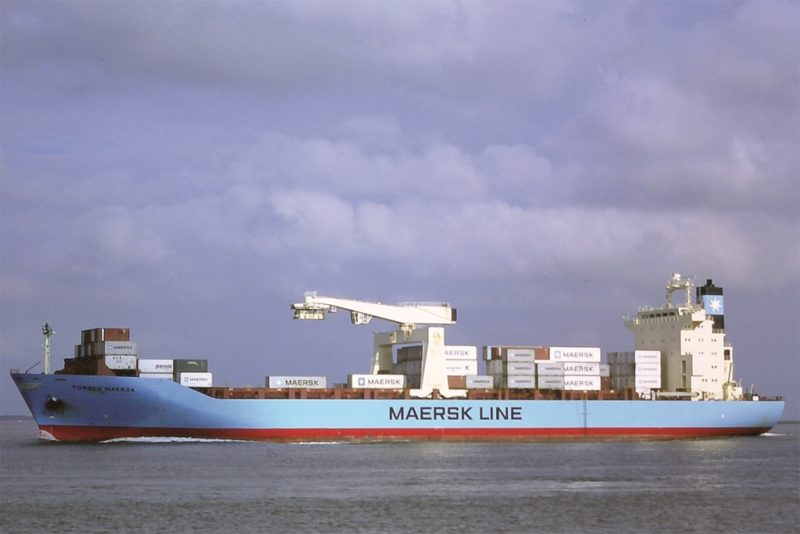
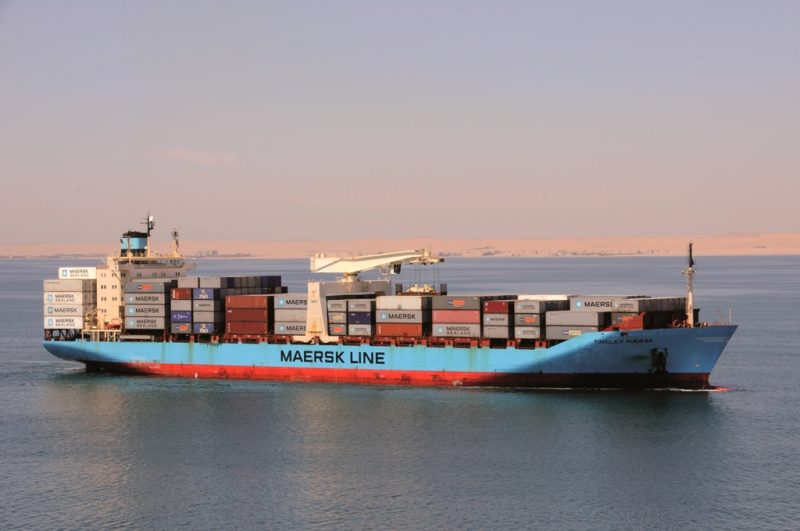
The old C. K. Hansen offices in the Esplanaden were taken over by the Group in 1986 near their new large and impressive Head Office on the waterfront in Copenhagen beside the Kastellet, the fortified citadel built in the 1660s. The previous Head Office had been at Kongens Nytorv 8 (King’s New Square) near the Charlottenborg Palace from 1915 to 1979
In June 1986, a 370 tonne three deck oil rig accommodation module was lifted on to the aft hatches of container ship Anders Mærsk at Dubai. Container ships regularly carry heavy lift items e.g. main engines, yachts, electricity generator rotors and stators etc, either on deck surrounded by containers for protection from the elements and rogue waves or down in the holds with the container guides stripped out.
The first of five ‘R’ class product and chemical tankers was named on 5th July 1986 at the Odense yard by Mrs. Suzette Wilhjelm, wife of the Danish Minister of Industry. The second of the class was named as Ras Mærsk on 4th October, with the others following as Romo Mærsk, Rasmine Mærsk and Rita Mærsk.The quintet were taken on charter by Shell and other oil majors for North European coastal trading. The maiden voyage of Robert Mærsk was however to the U.S. Eastern Seaboard from Aarhus and Rostock with urea, returning from Miami to Dublin and Amsterdam with molasses.
Lica Mærsk became the last of the ‘L’ class container ships to be lengthened by 50 metres at the Innoshima yard of Hitachi Zosen in January 1987 to bring her capacity up to 3,016 TEU, with sister Regina Mærsk completing the same lengthening process in June. The first Panamax container ship was delivered as Marchen Mærsk in April 1988, with sixteen sister ships following over the next ten years. Leda Mærsk made the first direct liner call at a U.K. port when she docked at Felixstowe on 19th September 1988 from the U.S.A., followed by her ‘L’ class sisters at regular intervals. Previously, U.K. cargo used feeder links from Tilbury to Rotterdam and Antwerp, and from Hull and Grangemouth to Bremerhaven. Michael Palin completed his ‘Round the World’ odyssey as a passenger on the ‘L’ class container ship Leda Mærsk at Felixstowe on 12th December 1989.
The first of four VLCCs of 255,000 dwt was completed at the Ulsan yard of Hyundai Heavy Industries in January 1989 as Nicoline Mærsk, and she sailed on her maiden voyage to Juaymah Terminal in the Persian Gulf to load crude oil. The remaining trio of VLCCs was completed by the end of the year. However, Mæersk Navigator was heavily damaged on 20th January 1993 in a collision with the Japanese tanker Sanko Honour near the entrance to the Straits of Malacca and both ships caught fire. The blaze on the Møller ship was extinguished eight days later, and she was towed still smoking into Singapore, where she was repaired and returned to service. She had been on a voyage from the Persian Gulf to Okinawa. Two Aframax tankers of 110,000 dwt were completed around the same time as the ‘N’ class and were renamed Mærsk Visual and Mærsk Virtue in 1992
Four ‘T’ class feeder container ships were completed at the Numakuma yard of Tsuneishi Zosen as Thorkil Maærsk, Tobias Mærsk, Torben Mærsk and Trein Mærsk, with a slightly larger pair following fouryears later as Thomas Mærsk and Tinglev Mærsk. They have been used as dedicated feeder ships for the Algeciras terminal and the Gioia Tauro terminal near the Straits of Messina. A further nine ‘C’ class feeder container ships were completed at Odense between 1992 and 1994, with all fifteen ships carrying between 1,150 and 1,500 TEU, of which 10% were refrigerated.
Mærsk Line and P. & O. Containers pooled their ships on the important Europe to Far East route in March 1991. The collaboration was extended in 1992 to the Europe to India, Red Sea and Persian Gulf routes, but this ended in 1996. In April 1993, Mærsk purchased the Far East container trades of East Asiatic Company (EAC) of Denmark and Ben Line of Leith. Seven of their large container ships were integrated into the Mærsk Europe to Far East and Round the World services and were given Mærsk names e.g. Edinburgh Mærsk. Four feeder routes between Bangkok and Singapore and between Indonesia and Singapore, and Australia to South East Asia, and Australia to Japan were also included in the takeover deal.
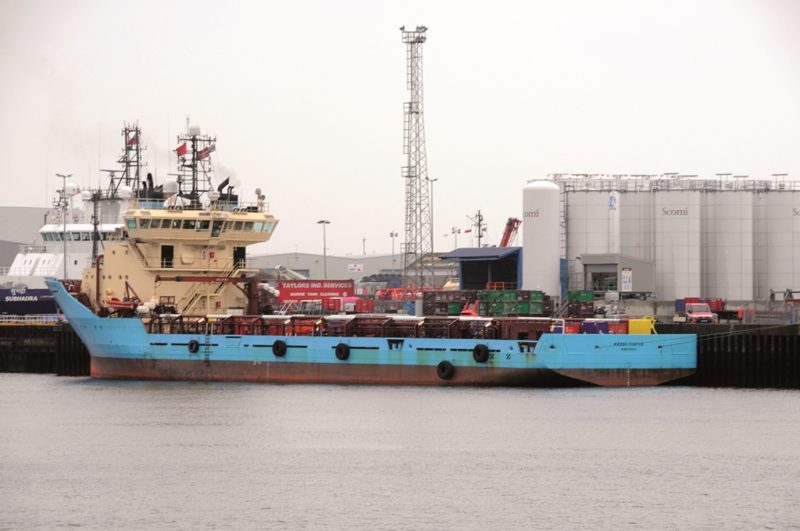
Mærsk McKinney Møller retired on 30th June 1993 as Chief Executive of the A. P. Møller Group of companies shortly before his 80th birthday on 13th July. However, his wish was to stay in control of the Group for as long as he lived, albeit in semi-retirement, and he thus still controlled the strings of his shipping empire. He remained as Chairman until his death on 16th April 2012 aged 98 years in Copenhagen. He had great longevity as the leader of the Group founded by his father Arnold Peter Møller(1876-1965). Soren Skou had become Chief Executive Officer in January 2012 but all major decisions still required his blessing until his death. The Group fleet at the time had 25,000 employees worldwide and it was the largest employer in Denmark
Two tankers were purchased in 1994 in an ‘en bloc’ deal from Western Pacific Co. Ltd. of Osaka. The newer Pacific Isis of 70,000 dwt was retained and renamed Mærsk Marlin, but the 1988 built Pacific Challenger of 41,000 dwt was immediately sold on to other owners. The first Mærsk cable layer also joined the fleet in 1994 as Mærsk Fighter. Oil production also began in 1994 at Qatar, which later became the jewel in the crown of the oilfields of Mærsk Olie og Gas.
The Mærsk Group formed a global container ship alliance with Sea-Land of the U.S.A. in 1995,which was acquired four years later from its owner CXS to form the largest container ship fleet in the world, and twice the size of its nearest competitor at 260 container ships. The largest container ship in the world of Post-Panamax size was delivered in February 1996 as Regina Mærsk from the Lindo yard, which also built her sister Sovereign Mærsk in 1997, and 28 similar ships over the next eight years.
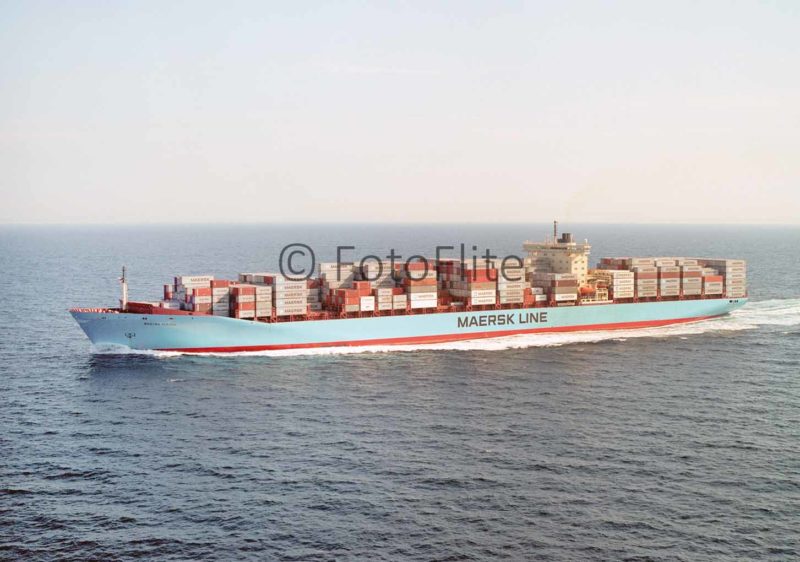
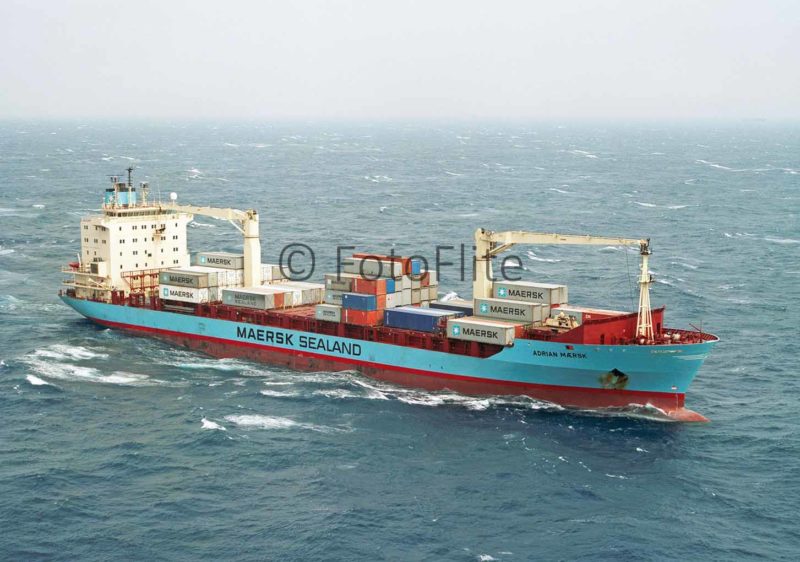
Adrian Mærsk, the first of ten ‘A’ class feeder container ships was completed in July 1998 by the China Shipbuilding Corporation at Keelung and able to carry 1,098 TEU of containers. The ‘A’ class were used as dedicated feeder container ships for the Algeciras and Gioia Tauro terminals, and also on the Europe to South Africa trades. Mærsk Ahram was registered under Mærsk Egypt S.A.E. and was used as a dedicated feeder between Gioia Tauro and Alexandria. The Møller shipbuilding business became international during 1994/98 with the acquisition of the Loksa yard in Estonia, the Baltija yard in Lithuania.
Safmarine of South Africa was taken over in 1999 with liner services from South Africa to Europe and West Africa. Safmarine ships kept their white hull colours and funnel colours and ‘Safmarine’ logo on their hulls, but all other Group container ships had ‘MæRSK-SEALAND’ boldly emblazoned on each side of their hulls. Weekly Safmarine and Mærsk services operated from Tilbury to South Africa, Namibia, the Canaries, Egypt, Belgium, France, Germany and The Netherlands. Vessels on these routes have included forty ships with ‘Safmarine’ prefixes to their names and the Stralsund yard of Volkswerft in Germany.
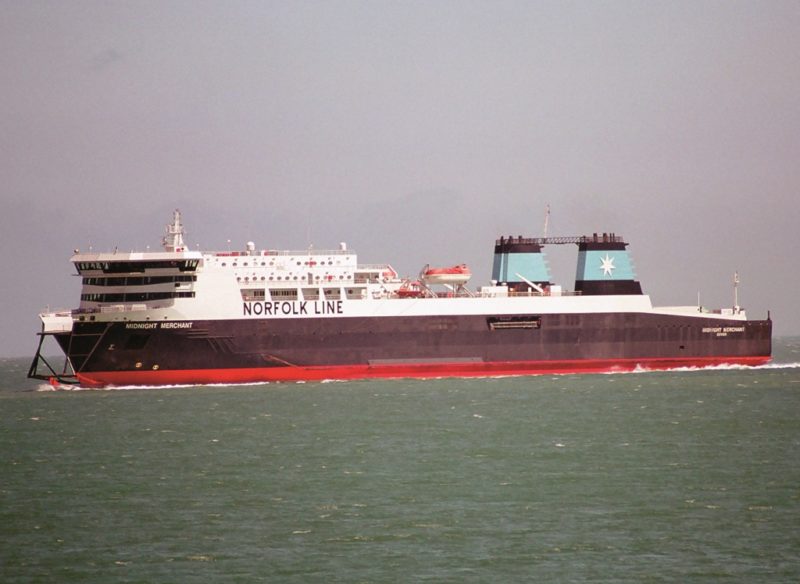
A Dover to Dunkirk ro-ro and passenger service was launched by Norfolk Line in 2000 using the Spanish built sisters Northern Merchant and Midnight Merchant, joined two years later by a third sister Dawn Merchant, all on charter from Cenargo. The wisdom of using Dunkirk instead of the Calais ferry terminals was shown in the early months of 2005 when Calais was out of action for a very long time, resulting in severe closures and disruption of services. The chartered trio of Spanish built ferries was replaced during 2005/06 by three new owned ro-pax ferries with capacity for 700 passengers, 200 cars,120 lorries and service speeds of 25 knots. They had separate decks for cars and lorries and the first began service as Mærsk Dover and Mærsk Dunkerque on delivery from Samsung Heavy Industries at Koje Island, Korea. They had 30% additional capacity over the original trio and offered more than the 20 sailings per day of the original service. A £250 million take-over of Norse Merchant Ferries, a subsidiary created by Cenargo on the Irish Sea, by Norfolk Line was accepted on 29th June 2005 and created further opportunities for growth in addition to existing Birkenhead to Dublin and Birkenhead to Belfast services. In 2006, over 1.5 million passengers and over 1.2 million freight movements were carried on the Dover to Dunkirk route, and the Irish Sea routes. Fellow Danes of DFDS Seaways took over Norfolk Line in July 2010and integrated the routes and ferries into DFDS Seaways, renaming and repainted the ferries with DFDS logos.
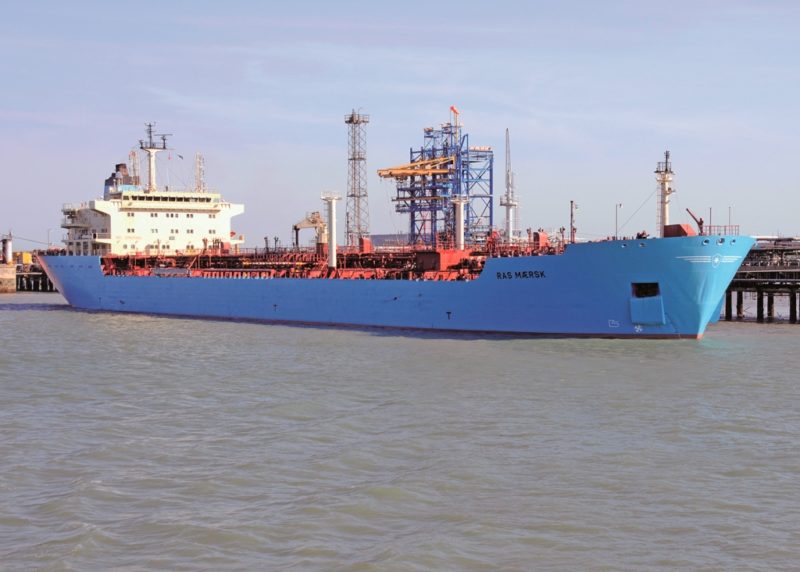
Ras Mærsk was the first of twenty ‘R’ Class product tankers of 30,000 dwt when she was completed at the Guangzhou Shipyard in China in 1999, with the rest of the class following up to 2005 for charter to European coastal trading. Mærsk Rye, one of her sisters, arrived at Blyth in July 2001 to be fitted with oil loading equipment for use as a shuttle tanker. Nine ‘P’ class Aframax tankers of 85,000 dwt were completed at the New Dalian yard in China around this time, the first being immediately taken on long term charter to Shell and renamed Donax, with another three years later as Dromus.
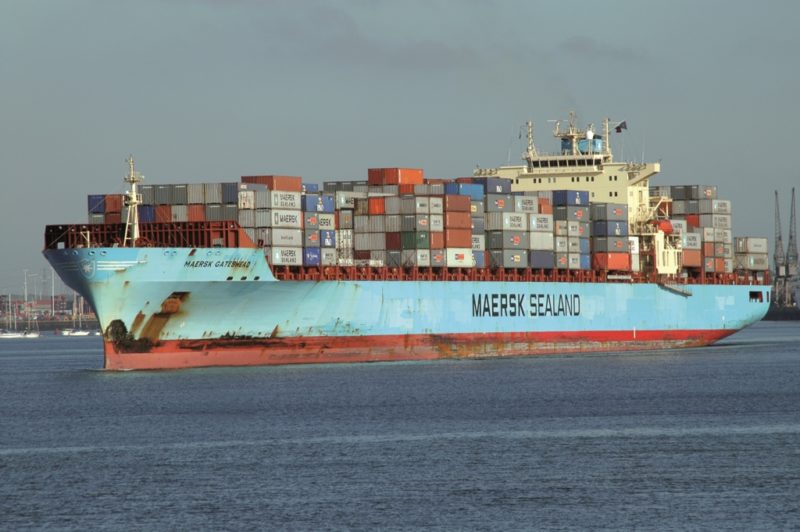
Mærsk Logistics was formed in Millennium year, combining CSX Logistics from the Sealand acquisition with Group logistics, and expanded with the acquisition of more logistics businesses in the U.S.A., Australia, France and Finland e.g. O’Neill and Whitaker of the United States. Group sales in 2002were $21.4 billion with some 60,000 employees worldwide, the Roulunds subsidiary was then sold off as well as its medical products subsidiary Mærsk Medical. The Group acquired the West African liner business of Torm of Denmark in 2002, comprising four vessels on a U.S. Gulf and Eastern Seaboard service to West Africa.

Thirteen intermediate size container ships entered service between 2001 and 2003, comprising four ‘J’ class, six ‘N’ class, and three ‘O’ class of varying TEU capacity around 2,800 TEU. Seven larger ‘L’ class and a dozen ‘G’ class also entered service at this time over a five year period, each carrying around 4,000 TEU. Six of the ‘G’ class were owned by Maersk Co. Ltd. of London and were named after British cities, towns and villages e.g. Gateshead, Grasmere, Gosport, Greenwich, Glasgow and Gairloch. Threewere owned by Mærsk Line Ltd. of the U.S.A. as Mærsk Georgia, Mærsk Missouri and Mærsk Carolina, and two were named as Mærsk Gironde and Mærsk Garonne of MærskMarine France, while Mærsk Geelong operated in the Antipodes for Mærsk Australia.
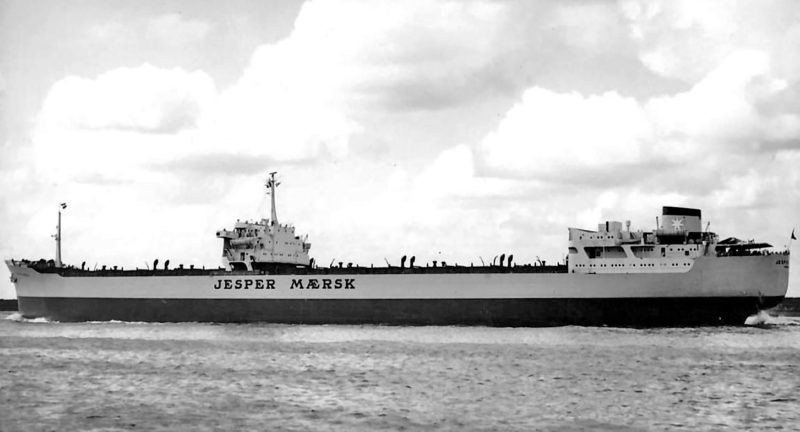



Comments
Sorry, comments are closed for this item